|
|
|
Sort Order |
|
|
|
Items / Page
|
|
|
|
|
|
|
| Srl | Item |
| 1 |
ID:
066258
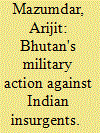

|
|
|
|
|
| Publication |
2005.
|
| Description |
p566-580
|
|
|
|
|
|
|
|
|
|
|
|
|
|
|
|
| 2 |
ID:
179351
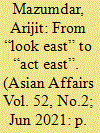

|
|
|
|
|
| Summary/Abstract |
In 1991, India's Prime Minister P.V. Narasimha Rao outlined the ‘Look East' policy, designed to address India's neglect of the Southeast Asian region during the Cold War period. The purpose of the Look East policy initially was to build closer economic and cultural ties with the countries of the region and with ASEAN in particular. The current Modi administration's new ‘Act East' policy has sought to expand these ties to include deeper security cooperation and defense partnerships as well. In addition, the new policy focuses on building ties with countries in the wider Asia-Pacific region, including Australia, New Zealand, Japan, and South Korea. The new policy is more than an exercise in rebranding. The primary goals behind the Act East policy are both to promote India's economic growth and development and respond to China’s rise and expanding influence in the region. However, India needs to be mindful about the challenges associated with the implementation of this policy.
|
|
|
|
|
|
|
|
|
|
|
|
|
|
|
|
| 3 |
ID:
173798
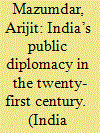

|
|
|
|
|
| Summary/Abstract |
In recent years, several countries have made sustained efforts to project their ‘soft power’ abroad. Public diplomacy has been an important tool for this purpose. Public diplomacy involves activities usually undertaken by a national government to inform and influence foreign public opinion and attitudes in order to advance its foreign policy goals. Such activities include ‘nation-branding’, diaspora outreach, digital engagement, international broadcasting, and international exchange programmes, all of which are designed to promote a positive image and reputation of the country to a global audience. This paper discusses the role of public diplomacy in the service of India’s foreign policy goals during the twenty-first century. The practice of public diplomacy helps the country achieve two significant objectives. First, it helps allay any active or dormant fears within the international community about India as a rising power. Second, it helps India compete with other countries as it seeks to boost foreign tourist arrivals, attract foreign investment and secure new markets for its exports in an era of globalisation. This paper also briefly discusses some of the challenges associated with India’s use of public diplomacy.
|
|
|
|
|
|
|
|
|
|
|
|
|
|
|
|
| 4 |
ID:
160676
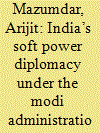

|
|
|
|
|
| Summary/Abstract |
This paper examines the Narendra Modi administration's use of three specific soft power assets of India – Buddhism, Diaspora, and Yoga – in diplomacy in service of the country's national interests. It attempts to address the following questions: What is the main purpose of the Modi administration's soft power strategy and the reasons behind the promotion and utilization of these three assets? What are the impediments to India's soft power projection ability? Finally, how can the Modi administration better exploit India's soft power advantages? This paper demonstrates how the Modi administration is making efforts to project India's soft power in the service of larger strategic goals. The use of soft power is designed to complement India's conventional diplomacy, boost its international image, project it as a peaceful rising power, improve relations with other countries, and help attract foreign investment, technology, and tourists in order to promote economic growth and development.
|
|
|
|
|
|
|
|
|
|
|
|
|
|
|
|
| 5 |
ID:
110822
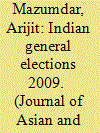

|
|
|
|
|
| Publication |
2012.
|
| Summary/Abstract |
This article argues that the results of the Indian General Elections, 2009, emphasize continuity more than change. Regional political parties, local-level issues and identity-based politics remain significant. The verdict represents a confirmation of established patterns of electoral politics in India and not a break with the recent past.
|
|
|
|
|
|
|
|
|
|
|
|
|
|
|
|
| 6 |
ID:
105975
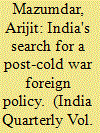

|
|
|
|
|
| Publication |
2011.
|
| Summary/Abstract |
During much of the Cold War, India chose to pursue a non-aligned foreign policy posture. The collapse of the Soviet Union and the end of the Cold War forced India to redefine its foreign policy and search for a new place in the emerging international order. However, almost 20 years on, India's foreign policy still appears to lack a coherent strategic doctrine. This article identifies some of the domestic factors that hampered the development of a post-Cold War 'grand strategy'. It argues that the emergence of coalition governments at the national level since the early 1990s, the country's federal structure, weaknesses in India's foreign policy institutions and the lack of a strategic culture within the country together constrain India's search for a post-Cold War foreign policy.
|
|
|
|
|
|
|
|
|
|
|
|
|
|
|
|
| 7 |
ID:
126096
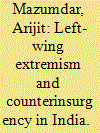

|
|
|
|
|
| Publication |
2013.
|
| Summary/Abstract |
India has a long history of left-wing extremism. The largest and most powerful left-wing extremist group today is the Communist Party of India (CPI) (Maoist), which is active in many states across the country. Its ultimate goal is to capture power through a combination of armed insurgency and mass mobilisation. In recent times, the southern state of Andhra Pradesh has achieved notable success in counterinsurgency operations against the Maoists. This article outlines the 'Andhra model', which involves a mix of security, development and political approaches. It also examines whether this model can be replicated in other Indian states affected by left-wing extremism.
|
|
|
|
|
|
|
|
|
|
|
|
|
|
|
|
|
|
|
|
|